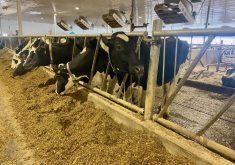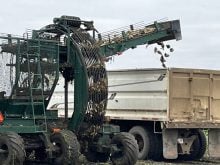A single operator using modern diesel-powered haymaking equipment can put up as much forage in a single day as an army of peasants a century ago would have been able to do in a week.
But if supply disruptions or outright scarcity cause fuel prices to sprout wings and soar out of sight, livestock producers might have to start making “other arrangements,” says Peter Vido. He and his wife and three children farm 230 acres in Lower Kintore, New Brunswick.
In the future, those who can afford to buy fuel will still use it to power modern equipment, he said. But what about those who can’t?
Read Also

Accurate accounting, inventory records are important
Maintaining detailed accounting and inventory records is not just a best practice; it’s a critical component of financial health, operational efficiency and compliance with programs like AgriStability.
Many farmers, especially those in developing countries, have already dropped out of the fuel bidding war. If the price of oil continues to go higher, more may be forced to join their ranks in coming years.
Originally from Slovakia, Vido has been farming for three decades. First, he tried the modern way with tractors and chemical inputs. Later, he apprenticed with Old Order Mennonites in Ontario to learn how to farm organically with horses.
Two decades ago, he sold his horses, believing that the scythe was a better, healthier way for his family to achieve their goal of “living with less.”
He began making trips to central Europe in a quest to rediscover the original peasant knowledge of cutting hay with the scythe. Since then, he has become the leading proponent for reintroducing the scythe to North America.
For most, the scythe is a symbol of death carried over the shoulder of the Grim Reaper. To old-timers on the Prairies, it is a reminder of the back-breaking labour of pioneer life.
But to Vido, it is the “ultimate survival tool.
“You can feed a few goats or a couple of cows from ditches and marginal lands just with a scythe,” he said.
“A lot of homesteaders don’t realize that they could cut 10 acres of hay all by hand,” he added. “They don’t realize that their team of horses is going to eat as much hay as they are going to make for their sheep. They are really better off with the scythe and to leave the horses alone.”
Apart from the fact that the number of antique mowers in good condition is dwindling every year, he said, many well-intentioned people don’t have what it takes to work with horses.
“It’s like me trying to use high-tech instruments. My brain just stops.”
A good scythe blade, on the other hand, will last a lifetime, and a snath, or handle, can be easily made from a hardwood sapling with a drawknife and saw.
Used in various forms for 2,500 years, the scythe reached its apex of perfection in the hands of Central European farmers, who still use them today to gather hay on steep mountainous slopes, he said.
The best blades are manufactured in Austria at factories with trip hammers, just as they were 500 years ago.
Unlike scythes of British or North American design, which are heavy, flat and difficult to sharpen due to their hardened steel, Austrian scythe blades are thin, light and curved upward slightly at the tip.
The bottom of the blade has a rounded belly that allows it to slide on the ground. The snath is straight except for a slight curve where it joins the blade.
A human mower, leaning slightly forward with legs planted apart, gently swings the scythe in a wide half circle – like a hockey player gently passing the puck rather than making a slap shot.
Correctly fitting the snath to a well-honed and properly adjusted blade is only half the battle, he said. Learning how to use it so that mowing becomes virtually effortless is the other half.
“It’s child’s play if you do it right,” said Vido, who added that real peasants consider cutting hay with a scythe a respite from more laborious farm work.
“They used to say in Austria, if you can’t rest yourself while mowing, you’re doing it wrong.”
Proper technique is critical, added Botan Anderson, who operates Mystic Prairie Eco-Farm in Wilson, Wisconsin.
A scythe seller and instructor, he uses the tool to cut bedding for his layer ducks and for mulch for his garden.
Anderson, who is a tall and lanky 6’5″, at first struggled with a dull blade and a too-short snath until he attended the International Scythe Symposium held at Vido’s farm in 2006.
“Within five minutes, I was mowing a 12-foot-wide swath. It sliced easier than a hot knife through butter,” he said.
Vido gives his blade a few licks every five minutes or so with the stone, kept constantly wet in a special belt holder, and peens the cutting edge after every few hours with a small hammer on a specially shaped jig or anvil. Peening the blade cold packs the thin steel edge for maximum sharpness.
Under ideal conditions, Vido said a skilled mower could drop half an acre of hay in three hours, or a full acre in a day with a pre-dawn start.
Fairlight, the eldest of his daughters, gained local fame at the age of 15 when she entered a mowing contest at the Second Annual Maritime Hand Mowing Championship in 2005.
Barefoot with her scythe, she trounced the competition, which included a grown man armed with a gas-powered weed whacker, and did a nicer job to boot, said Vido’s son Kai, who handles sales and marketing for the family’s scythe business.
Through mainly word-of-mouth advertising and their website, www.scytheconnection.com, they sell 75 to 100 units a year, plus an equal amount of wholesale business to other outlets, mainly on-farm operations and small retailers, said Kai.














